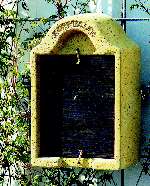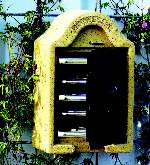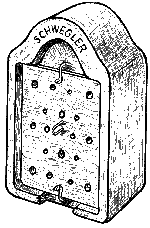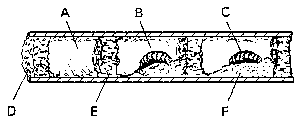Insect Housefor Solitary Insects(D.B.P.)for observation (very well suited for educational use) | |||
 [Pic. 1]: Insect House  [Pic. 2]: Insect House (opened, with visible observation tubes)  [Pic. 3]: Insect House  [Pic. 4]: Insect House (opened)  [Pic. 5]: brood cell with egg on pollen bread  [Pic. 6]: brood cell with feeding larva  [Pic. 7]: brood cell with pupa in cocoon, cut open | Conservation and educationThis SCHWEGLER products provide homes for useful creatures such as solitary bees, parasitical hymenoptera, ants, spiders and other small creatures. They also let you study your insects and observe their life cycle. Whether in the garden or on a balcony, these nesting aids are a reliable and relaxing way of making observations and gaining knowledge. Closer contact with this group of animals, and an awareness of their beauty, are the basis for greater respect for wildlife. These nesting aids are prefect for nurseries, schools, colleges and wildlife centres as well as private gardens. Their designs allow creatures to be observed with minimal disturbance. SCHWEGLER Insect House(D.B.P)This is intended for the same occupants as the nesting aids on the previous pages. For the first time, it is now possible to study the previously hidden life and development of our solitary bees and wasps by lifting out the front panel with its transparent nesting tubes. It is possible to watch the cycle from egg-laying to development of the larvae, right up until the time the insect leaves the brood chamber the next season. Note that it is essential to properly replace the front panel after each inspection to keep the insects in darkness. Suitable sites: There are no hard and fast rules for siting but care should be taken to select a sunny site that is protected from wind and rain. Examples of good sites include allotment sheds, pergolas, walls, gardens and even balconies up to the third or fourth floor. Nesting aids should also be left outside during the winter because otherwise the insects will emerge from their winter hiding places too early and die. Occupants: Hymenoptera such as wild bees, sand wasps and common wasps. Material: - box: wood-concrete with weatherproof wooden front panel - interior: transparent nesting tubes of different diameters Colour: Box: sand, black insert Dimensions: height 33 x width 21 x depth 15 cm Weight: ca. 9,2 kg
THIS ARTICLE IS REGULARLY USED IN EDUCATIONAL PROJECTS, SCHOOLS AND NURSERIES | ||
 [Pic. 8]: mason bee breeding tube | Structure of a mason bee breeding tube (see Pic. 8) A: empty cell B: brood cell C: larvae D: nest seal E: partition F: pollen bread |

